Brushing your cat's teeth might seem like navigating uncharted territory, filled with potential hisses and swipes. Yet, establishing a dental care routine is a pivotal step in safeguarding your feline friend's health and ensuring those purrs stay happy and healthy. Research indicates that 50 to 90% of cats over the age of four years experience some degree of dental disease.
In our comprehensive guide to brushing your cat's teeth, we'll demystify the process step by step, transforming what might appear daunting into a seamless part of your daily routine. Whether you're a seasoned cat parent or new to feline care, our guide empowers you with the knowledge and confidence to maintain your cat's dental health, ensuring those tiny teeth sparkle with health and vitality.
Preparing to Brush Your Cat's Teeth
1. Start Slow

Start by acclimating your cat to having their mouth and teeth handled. This can be done during calm, cuddly moments when your cat is relaxed. Gently stroke your cat's cheeks and lift their lips to expose the gums and teeth, all while speaking softly to keep them calm. Depending on your cat's tolerance level, this process should be repeated over several days or weeks.
2. Introduce Cat Toothpaste
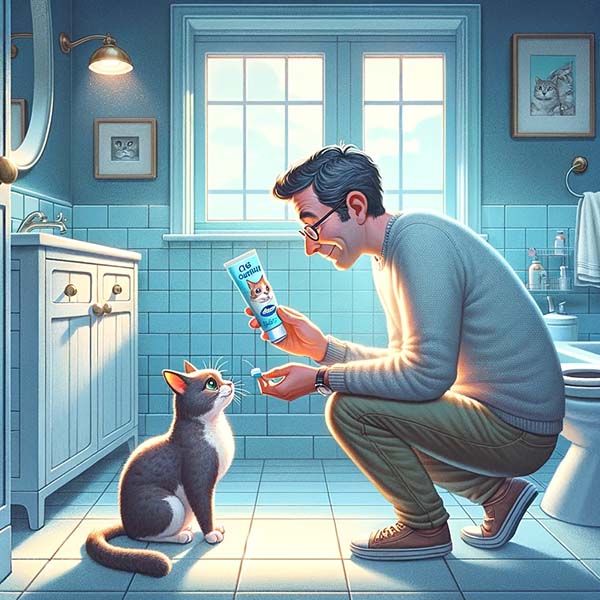
Once your cat is comfortable touching their mouth, introduce them to cat-specific toothpaste. These toothpastes are available in flavors that cats find appealing, such as chicken or fish, enhancing the overall experience. Allow your cat to sample the toothpaste from your finger to become accustomed to the texture and flavor. Avoid using human toothpaste, as it contains ingredients that can be harmful to cats.
3. Associate Touching Teeth with Positive Experiences

As your cat becomes more comfortable with the toothpaste, start to gently rub their teeth and gums with your finger. You can wrap your finger with gauze and apply a small amount of toothpaste. This step assists them in becoming accustomed to the sensation of something other than their tongue or food coming into contact with their teeth. Always pair this activity with positive reinforcement, such as petting, praise, or a favorite treat.
4. Gradually Introduce a Cat Toothbrush
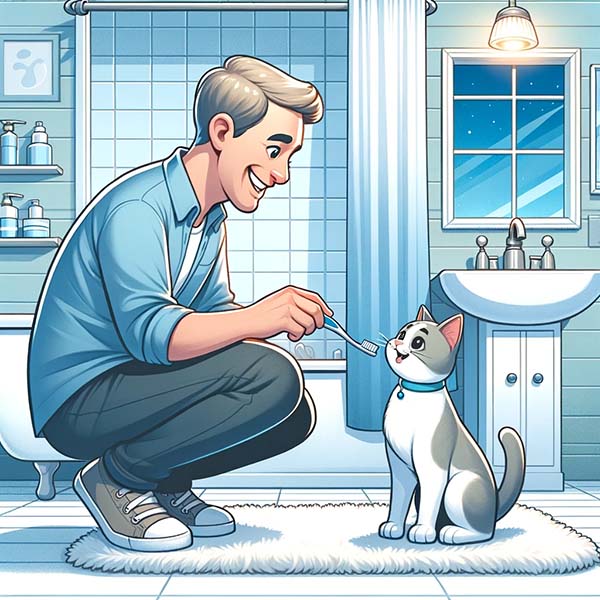
Choose a soft-bristled toothbrush designed for cats or a finger toothbrush that fits over your fingertip. Let your cat inspect and sniff the toothbrush to become familiar with it. Initially, you might just touch the brush to their teeth without brushing, gradually building up to gentle brushing motions as they become more comfortable.
5. Keep Sessions Short and Sweet
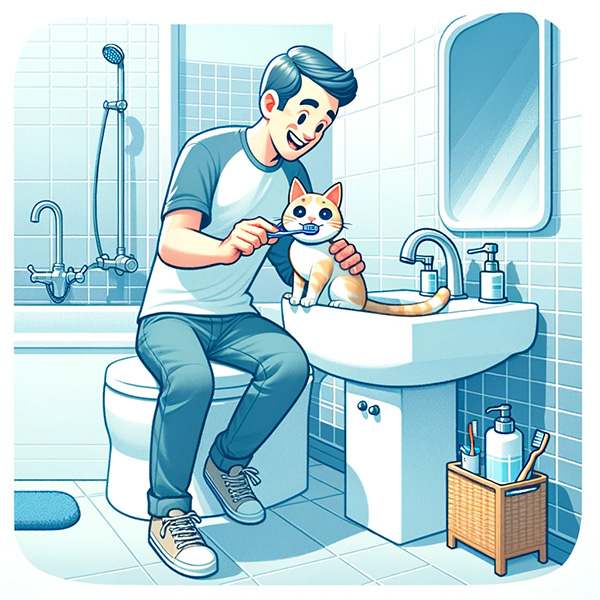
Initially, keep the brushing sessions short to avoid overwhelming your cat. Initially, aim for a duration of a few seconds to a minute. You can gradually extend the brushing time as your cat grows more accustomed to the process.
Choosing the Right Supplies
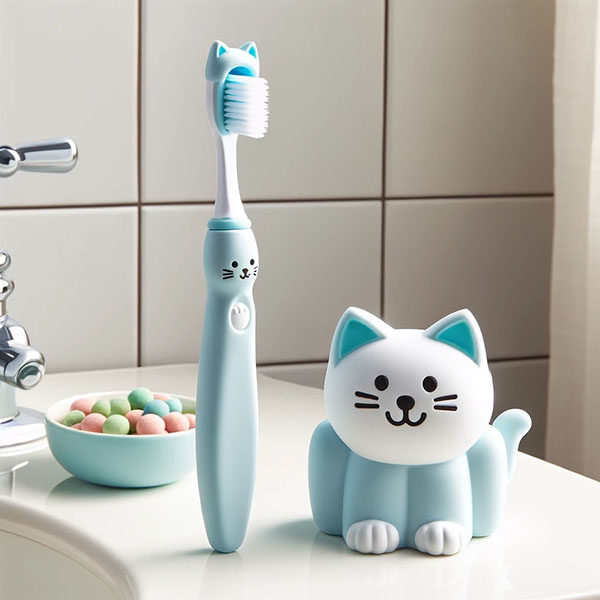
Cat-Specific Toothbrush
When selecting a toothbrush for your cat, look for one specifically designed for feline oral anatomy. Cat toothbrushes are typically smaller than human toothbrushes and have softer bristles to gently clean the teeth without irritating the gums. There are a few types to choose from:
Finger Toothbrush: A finger toothbrush fits over your fingertip, giving you more control and sensitivity when brushing your cat's teeth. This can be a good option for cats who are initially wary of the brushing process, as it feels more like a familiar touch.
Angled Toothbrush: Some cat toothbrushes feature an angled head designed to reach the back teeth and other hard-to-reach areas more easily.
Dual-Head Toothbrush: This type of toothbrush has heads of two different sizes at either end, allowing for more flexibility depending on which part of your cat’s mouth you are cleaning.
Pet-Safe Toothpaste
It's crucial to use toothpaste formulated specifically for pets. These kinds of toothpaste are available in flavors that cats find appealing, such as poultry, beef, or fish, enhancing their brushing experience. Unlike human toothpaste, pet toothpaste is safe for cats to ingest, which is important since they cannot spit it out. Here’s why human toothpaste is not suitable:
Toxic Ingredients: Human toothpaste often contains ingredients like xylitol, fluoride, and detergents that are toxic to cats if ingested.
Unappealing Flavors: The minty flavors of human toothpaste are unappealing to most cats and can make the brushing experience unpleasant.
Additional Supplies
Besides the toothbrush and toothpaste, you might also consider dental wipes and cat dental chews as supplementary tools when brushing is impossible. These can help remove some plaque and are particularly useful for cats still getting used to cleaning their teeth.
Step-by-Step Guide to Brushing
Step 1: Position the Cat Correctly

Positioning your cat correctly is pivotal for a successful and stress-free brushing session. The objective is to ensure your cat feels secure while granting you easy access to their mouth. Begin by choosing a quiet, well-lit area where your cat feels comfortable. Some cats prefer to be at a high vantage point, so consider a table or countertop, ensuring there's a non-slip surface beneath them.
Gently hold your cat in your lap, facing away from you, or position them beside you with their side against your body and title your cat's head upward. Use one arm to gently cradle your cat's body, providing reassurance with soft strokes.
The key is to maintain a gentle but firm hold that prevents them from backing away without making them feel restrained. For some cats, wrapping them lightly in a towel or blanket can provide additional security and reduce their ability to squirm.
Step 2: Introduce the Cat Toothbrush and Toothpaste
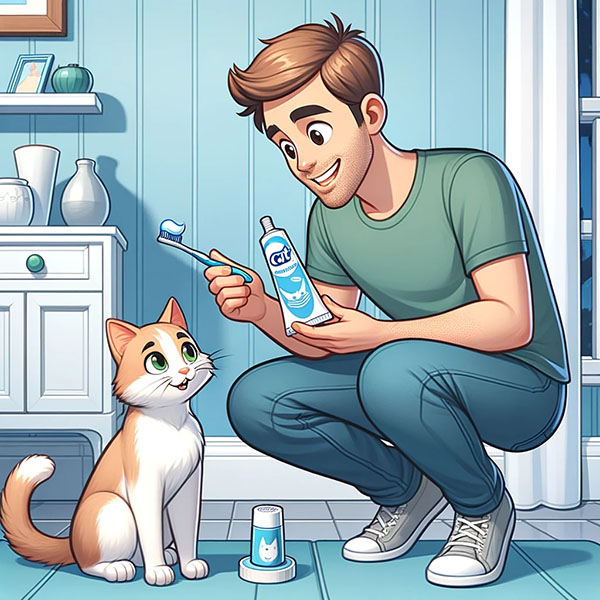
Familiarizing your cat with the toothbrush and toothpaste before starting the actual brushing is crucial to ensure they don't become fearful of these new items. Begin by allowing your cat to sniff and lick the toothpaste from your finger to become accustomed to its taste. Choose a pet-safe cat toothpaste with a flavor appealing to cats, like chicken or fish. Next, introduce the toothbrush, allowing your cat to examine it at their own pace. You might dab a little toothpaste on the brush and let them taste it from the bristles. This step should be repeated over several days, gradually building your cat's comfort level and curiosity without any pressure to brush.
Step 3: The Brushing Process
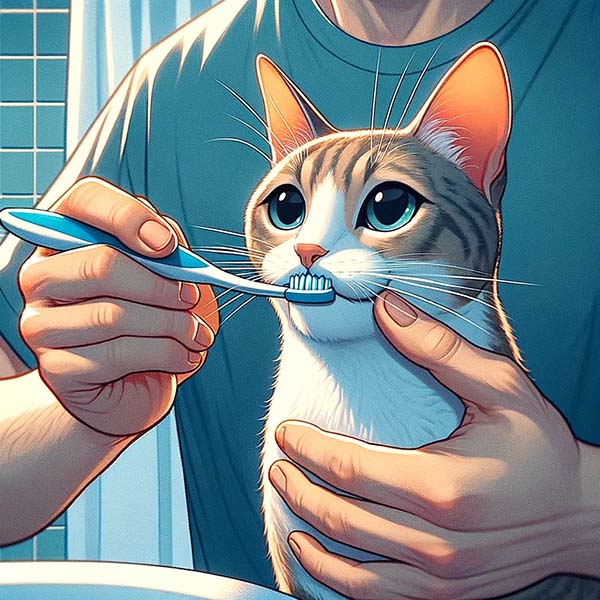
Once your cat is at ease with the toothbrush and toothpaste, you can begin brushing. Apply a small, pea-sized amount of toothpaste to the brush. Gently raise your cat's lip to reveal their teeth and gums. Using a soft, circular motion, start brushing at a 45-degree angle to the gum line, focusing on the outside surfaces of the teeth where plaque tends to accumulate. There's no need to brush the inside surfaces as thoroughly; the cat's tongue naturally keeps this area cleaner.
To open your cat's mouth, you may gently press on their upper jaw with your thumb and lower jaw with your fingers, but many cats will not tolerate this well, so focus on accessible areas without forcing their mouth open. Employ gentle strokes, allocating approximately 30 seconds to a minute to each side of the mouth. If your cat permits, gently brush all of their teeth or focus on a few teeth at a time.
Step 4: Finishing Up

Concluding the brushing session on a positive note is essential for ensuring it's a good experience for your cat, setting the stage for future sessions. After you've finished brushing, offer plenty of praise and a favorite treat or playtime as a reward. This positive reinforcement helps your cat associate tooth brushing with enjoyable outcomes. Carefully observe your cat's behavior throughout the process and adjust accordingly; if they show signs of stress or discomfort, it's better to end the session early and try again later. Building a positive routine takes time and patience, but with consistent effort, your cat will learn to tolerate, and possibly even enjoy, their dental care routine.
Step 5: Maintaining a Routine
A consistent brushing routine is crucial for removing plaque before it hardens into tartar, which can occur in as little as 24 hours. Plaque buildup under the gumline can lead to gingivitis and, if not addressed, progress to periodontal disease, affecting the tissues and bone that support the teeth. Regular brushing helps maintain healthy gums and teeth, preventing the development of oral diseases that can cause pain and lead to tooth loss. Moreover, establishing a routine helps your cat become accustomed to the process, gradually reducing stress for you and your pet over time.
Veterinary professionals generally recommend brushing your cat's teeth daily to prevent plaque and tartar buildup effectively. While daily brushing is ideal, it's understood that this may not be feasible for all pet owners due to various constraints. Striving for a minimum of three to four times a week can still provide significant benefits in maintaining your cat's oral health. Consistency is key; even less frequent brushing is better than none, but the more regularly you can brush, the better it is for your cat's dental hygiene.
In addition to at-home brushing, professional dental cleanings by a veterinarian play a critical role in your cat's oral health regimen. These cleanings enable the removal of plaque and tartar that have built up below the gum line, areas that are challenging to access through at-home brushing alone. A professional cleaning typically encompasses a comprehensive oral examination, scaling to eliminate plaque and tartar, and teeth polishing. It may also include more advanced procedures such as X-rays or extractions if necessary. Professional cleanings should be performed as your veterinarian recommends, usually once a year, but the frequency can vary depending on your cat's specific health needs and oral hygiene.
Dealing with Challenges
Brushing a cat's teeth can present several challenges, largely due to their natural temperament and the unfamiliarity of the brushing process. Nonetheless, these challenges can be successfully addressed or overcome with patience, understanding, and the appropriate approach. Here's a look at common challenges and potential solutions to make brushing your cat's teeth a smoother experience.
Challenge 1: Resistance to Brushing
Many cats resist having their teeth brushed due to discomfort, fear, or simply because it's a new experience.
Solution: Gradually acclimate your cat to the process. Begin by acclimating them to touching their mouth and gums without the brush. Then, gradually introduce a toothbrush and toothpaste specifically designed for cats, allowing them to sniff and lick the brush and toothpaste before attempting to brush. Positive reinforcement, through praise and treats, can also help make the experience more rewarding for your cat and allow your cat to accept tooth brushing.
Challenge 2: Difficulty in Handling the Cat
Some cats may not stay long enough for a thorough brushing, making cleaning all their teeth effectively difficult.
Solution: Try brushing your cat's teeth at a time when they are naturally calmer or more tired, such as after a meal or vigorous play. Holding your cat in a comfortable but secure position, such as in your lap or against your body, can also help. For some cats, wrapping them lightly in a towel (a technique often called a "kitty burrito") can provide comfort and reduce movement.
Challenge 3: Dislike of Toothpaste or Toothbrush
Cats may dislike the toothpaste's texture or flavor or the toothbrush's fell in their mouth.
Solution: Try out various flavors of pet-safe toothpaste to discover the one your cat enjoys the most. Introduce the toothbrush gradually, letting them get used to it as a toy or object of interest before using it in their mouth. A fingerbrush can sometimes be less intimidating than a traditional toothbrush.
Challenge 4: Negative Associations
If the first experiences with tooth brushing are negative, cats may develop a long-term aversion to the process.
Solution: Ensure each tooth brushing session is positive and stress-free. Begin with very brief sessions, gradually extending the duration as your cat grows more comfortable. Always conclude positively by offering a treat or engaging in a favorite activity.
Challenge 5: Oral Health Problems
Existing oral health problems can make brushing painful or uncomfortable, leading to resistance.
Solution: Before starting a brushing routine, have your cat's teeth checked by a veterinarian to address any dental issues. Regular check-ups can help prevent problems from developing or worsening, making brushing a more comfortable experience for your cat.
Challenge 6: Maintaining Consistency
Finding the time and energy to brush your cat's teeth regularly can be challenging for busy pet owners.
Solution: Create a schedule that suits your availability, even if it doesn't involve daily brushing. Consistency is more important than frequency, so a few regular times a week are better than daily sessions that are sporadically missed. Consider using dental cat treats or chew toys in between sessions to help maintain clean teeth.
